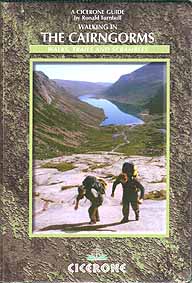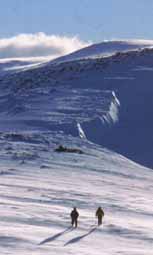CONTENTS | | |
|
| Introduction | | | |
| Why the Cairngorms? | | | |
| Walking conditions | | | |
| When to go | | | |
| Safety in the mountains | | | |
| Maps | | | |
| How to use this book | | | |
| | km | mls | level |
| Part 1 Aviemore and the Spey | | | |
| 1 Grantown and Spey | 12 | 7 | low |
| 2 Spey at Boat of Garten | 19 | 6 | low |
| 3 Craigellachie Birches | 5 | 3 | low |
| 4 Geal-charn Mor | 18 | 11 | Corbett |
| 5 Around Loch an Eilein | 5 | 3 | low |
| 6 Ord Ban | 7 | 4 | low |
| 7 Argyll Stone | 15 | 9 | medium |
| Part 2 Glen More | | | |
| 8 Gleann Einich and the Sgorans
| 27 | 17 | Munros |
| 9 Creag a’ Chalamain and the Cat Notch
| 16 | 10 | medium |
| 10 Down Cairn Gorm | 20 | 12 | low |
| 11 Lochan Uaine | 8 | 5 | low |
| 12 Meall a’ Bhuachaille
| 19 | 12 | Corbett |
| 13 Creag Mhor and Bynack More | 31 | 19 | Munro + Corbett |
| 14 Beinn Mheadhoin | 36 | 22 | Munro |
| Summit Summary: Cairn Gorm | | | |
| 15 Bynack More and the Saddle | | | |
| 16 Strath Nethy and the Saddle | | | |
| 17 Lairig an Lui, Loch Avon, Coire Raibert | | | |
| 18 Lochan na Beinne and Cnap Coire na Spreidhe | | | |
| 19 Coire Cas (descent) | | | |
| 20 Coire an t-Sneachda: Headwall | | | scramble Grade 1 |
| 21 Coire an t-Sneachda: Pygmy Ridge | | | scramble Grade 3 |
| 22 Coire an t-Sneachda: Goat Path | | | |
| 23 Fiacaill Ridge of Coire an t-Sneachda | | | scramble Grade 1 |
| 24 Lurcher’s Crag | | | |
| 25 Plateau route from Macdui | | | |
| Shelter Stone Summary | | | |
| 26 Strath Nethy and the Saddle | | | |
| 27 Lairig an Lui, Loch Avon | | | |
| 28 To Coire Cas or Cairn Gorm by Coire Raibert | | | |
| 29 From Coire Cas by Coire Domhain | | | |
| 30 From Linn of Dee by Loch Etchachan | | | |
| 31 To Ben Macdui by Loch Etchachan | | | |
| 32 To Carn Etchachan by Pinnacle Gully | | | scramble Grade 1 |
| 33 Forefinger Pinnacle | | | scramble Grade 3 |
| 34 To Ben Macdui by Avon Slabs | | | scramble Grade 1 or 2 |
Summit Summary: Ben Macdui
| | | |
| 35 From Lairig Ghru by Tailor Burn | | | |
| 36 From Derry Lodge by Carn a’ Mhaim
| | | |
| 37 Sron Riach | | | |
| 38 Via Derry Cairngorm | | | |
| 39 Coire Etchachan | | | |
| 40 From Coire Cas | | | |
| 41 Plateau route from Cairn Gorm | | | |
| Part 3 Badenoch | | | |
| 42 Badenoch Way | 8 | 11 | low, linear |
| 43 Insh to Aviemore | 28 | 17 | low, linear |
| 44 Druid Circle at Dalraddy | 10 | 6 | low |
| 45 Take an Insh | 11 | 7 | low |
| 46 Carn Dearg Mor | 20 | 12 | Corbett |
| 47 Mullach Clach a’ Bhlair by Coire Garbhlach | 19 | 12 | Munro |
| 48 Badan Mosach waterfall | 4 | 2 | low |
| 49 Summer Road to Ruthven | 9 | 6 | low |
| 50 Glen Tromie: Croidh-la | 16 | 10 | medium |
| 51 Creag Bheag | 7 | 4 | medium |
| Summit Summary: Braeriach | | | |
| 52 From Glenmore by Sron na Lairige | | | |
| 53 From Rothiemurchus by Sron na Lairige | | | |
| 54 Gleann Einich and Coire Ruadh | | | |
| 55 Gleann Einich and Coire Dhondail | | | |
| 56 Coire Dhondail scramble | | | scramble Grade 1 |
| 57 South Ridge of Coire Bhrocain | | | |
| 58 Ridge route from Cairn Toul | | | |
| Summit Summary: Cairn Toul | | | |
| 59 Coire Odhar | | | |
| 60 Great Moss | | | |
| 61 East Ridge | | | scramble Grade 1 |
| 62 North East Ridge of Angel’s Peak
| | | scramble Grade 1 |
| 63 Corrie of the Chokestone Gully | | | |
| 64 Ridge route from Braeriach | | | |
| Part 4 Glenlivet and Tomintoul
| | | |
| 65 Hills of Cromdale |
19 | 12 | medium |
| 66 Carn Daimh | 10 | 6 | medium |
| 67 Around the Brown | 13 | 8 | low |
| 68 Glen Brown and Ailnack Ravine | 19 | 12 | medium |
| 69 Ben Avon by its River | 40 | 24 | Munro |
| 70 Tors of Ben Avon | | | scramble Grade 1–2 |
| 71 Cnap Chaochan Aitinn | 29 | 19 | medium |
| 72 Ailnack Upper Ravine | 21 | 13 | scramble Grade 1 |
| Part 5 Donside | | | |
| 73 Carn Ealasaid | 16 | 10 | Corbett |
| 74 Brown Cow Hill | 19 | 11 | Corbett |
| 75 Don to Ben Avon
| 32 | 20 | Munro |
| Part 6 Deeside Braemar | | | |
| 76 Clais Fhearnaig | 16 | 10 | low |
| 77 Derry Cairngorm by Lochan Uaine | 23 | 14 | Munro |
| 78 The Happy Face of Beinn a’ Chaorainn | 29 | 18 | Munros |
| 79 Dee and Derry | 25 | 15 | medium |
| 80 Around Glen Geusachan
| 19 | 12 | Munros |
| 81 The Devil’s Back Side
| 6 | 4 | Munro |
| 82 Glen Quoich | 13 | 8 | low |
| 83 Beinn a’ Bhuird
| 28 | 18 | Munro |
| 84 Carn na Drochaide and the Fairy Glen
| 15 | 9 | Corbett |
| 85 Morrone Birkwood and the Dee
| 9 | 5 | low |
| 86 Morrone and Glen Ey
| 20 | 12 | Corbett |
| 87 Creag nan Gabhar | 13 | 8 | Corbett |
| 88 White Mounth and Jock’s Road | 27 | 17 | Munros |
| Part 7 Balmoral and Lochnagar |
| | |
| 89 Balmoral Castle | 8 | 5 | low |
| 90 Craigendarroch and the Dee
| 7 | 4 | low |
| 91 Around Loch Muick | 12 | 7 | low |
| 92 Dubh Loch and Broad Cairn
| 27 | 17 | Munros |
| 93 Creag an Dubh-loch
| 21 | 13 | Munros |
| Summit Summary: Lochnagar |
| | |
| 94 Queen Victoria’s Ballochbuie Route |
| | |
| 95 Byron’s scramble by the Stuic |
| | scramble Grade 1 |
| 96 Tracks from Balmoral |
| | |
| 97 Meall Coire na Saobhaidhe |
| | |
| 98 Tourist path from Spittal of Glenmuick |
| | |
| 99 Conachcraig |
| | |
| 100 Loch na Gaire |
| | |
| 101 Falls of Glas Allt (descent) |
| | |
| 102 From Loch Callater |
| | |
| | | |
| The Long Routes |
The Cairngorms 4000s |
| The Lairig Ghru |
| Appendices |
| | |
I Access (in particular during the deer stalking season)
II Mountain bothies
III Gaelic place names
IV Lists of hills
V Scrambles summary and grading
VI Accommodation and information
VII Further reading |

